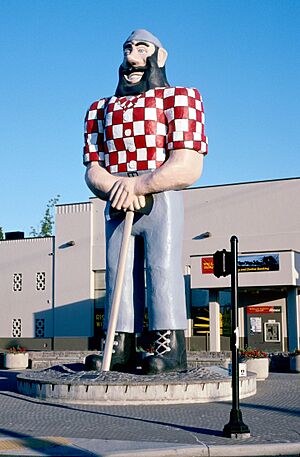Kenton, Portland, Oregon facts for kids
Quick facts for kids
Kenton
|
|
|---|---|
|
Neighborhood
|
|
| Country | United States |
| State | Oregon |
| City | Portland |
| Area | |
| • Total | 3.42 sq mi (8.87 km2) |
| Population | |
| • Total | 7,272 |
| • Density | 2,123.4/sq mi (819.8/km2) |
| Housing | |
| • No. of households | 2,707 |
| • Occupancy rate | 94% occupied |
| • Owner-occupied | 1,792 households (66%) |
| • Renting | 915 households (34%) |
| • Avg. household size | 2.56 persons |
Kenton is a cool neighborhood located in the northern part of Portland, Oregon, in the United States. It's a place with a unique history. It started as a "company town" in 1911. This means it was built mainly for the workers of a big business called the Swift Meat Packing Company.
Contents
Where is Kenton?
Kenton is bordered by water and major roads. To the north, you'll find the North Portland Harbor, which is a channel of the Columbia River. This channel separates Kenton from Hayden Island.
Kenton's Boundaries
The eastern side of Kenton is next to Interstate 5, a big highway. To the south, the neighborhood ends at North Lombard Street. On the western side, the border follows North Portland Road, North Columbia Boulevard, and North Chautauqua Boulevard. A waterway called the Columbia Slough also flows through Kenton.
Neighboring Areas
Kenton is surrounded by several other neighborhoods. These include Hayden Island to the north and Bridgeton, Sunderland, and Piedmont to the east. To the south, you'll find Arbor Lodge. In the southwest, it's next to University Park, and to the west are Portsmouth and St. Johns.
Fun Places in Kenton
Kenton is home to some exciting spots. You can find the Portland International Raceway here, which is a place for car and bike races. The Portland Metropolitan Expo Center is also in Kenton. This is a large venue where many events and shows happen.
Kenton also holds the historic site of Vanport. This was a huge housing project built during World War II for people who worked on building ships. Sadly, a big flood destroyed Vanport in 1948.
Kenton's Past: A Company Town
Before the 1900s, Kenton was mostly a farming area. It was similar to other small towns nearby. But then, the Swift Meat Packing Company decided to build a "company town" here. This meant they built homes and facilities for their workers.
Early Development
By 1910, many buildings were constructed in Kenton. These included concrete and brick structures. Two large, three-story brick hotels were also built. Other companies, like National Wood Pipe Company and Union Meat Company, also set up their plants in Kenton.
In 1909, the Mayor of Portland, Joseph Simon, visited Kenton. He promised improvements like paved roads, street lamps, and a fire station. At first, the streets were still dirt. A local group called the Kenton Push Club worked hard to convince the Portland City Council to pave the roads. After a lot of effort, the roads were finally paved in 1911. By 1913, a lot of money had been spent to make Kenton's streets smooth.
Growing Community Needs
As Kenton grew, people wanted more services. They asked for a park, a library, and a school. A few years later, Kenton, along with St. Johns, became part of the City of Portland. Kenton became a major center for the cattle trade on the West Coast for a while.
The Kenton Ghost and Baseball
In 1913, a strange story about a "Kenton ghost" appeared in The Oregonian newspaper. Many residents said they saw a shadowy figure. Even important people, like the secretary of the Interstate Bridge Commission, reported sightings. A group of people, led by former Albina Mayor W. M. Killingsworth, even went looking for the ghost!
Kenton also had its own semi-professional baseball team in 1916 and 1917. They were called the Kenton Giants and played in a league with three other teams.
Paul Bunyan Statue and Centennial
In 1959, Oregon celebrated its 100th birthday, called the Oregon Centennial. The celebrations were held right in Kenton! To remember this special event, a giant statue of Paul Bunyan was built. Paul Bunyan is a legendary giant lumberjack.
This statue stands at the corner of North Interstate Avenue and North Denver Avenue. It's a famous symbol of the neighborhood. The statue was even added to the National Register of Historic Places in 2009. Right across the street from Paul Bunyan, you can see the blue hooves of Babe the Blue Ox, his loyal animal friend.
The main business area of Kenton, known as the Kenton Commercial Historic District, was also added to the National Register of Historic Places in 2001. This was because of its important role in the neighborhood's and city's growth.
Famous People from Kenton
- Tina Kotek - She is the 39th Governor of Oregon. She has lived in Kenton since 2005.


